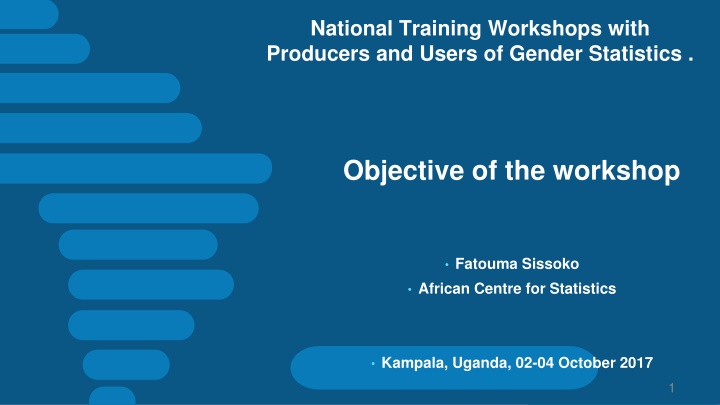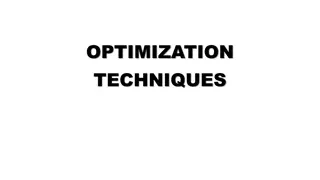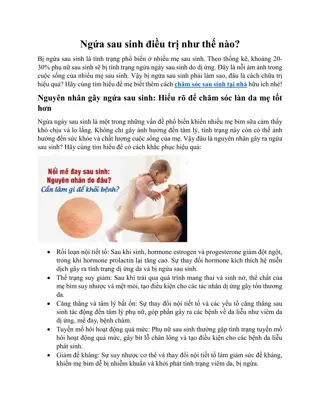
Empowering Statistical Capacity in Africa for Agenda 2063 & SDGs
Enhance your understanding of statistical capacity building for Agenda 2063 & SDGs in Africa through workshops, strategies like SHaSA, and global indicator frameworks. Explore how these initiatives aim to produce high-quality, disaggregated statistics to measure progress towards sustainable development goals.
Download Presentation

Please find below an Image/Link to download the presentation.
The content on the website is provided AS IS for your information and personal use only. It may not be sold, licensed, or shared on other websites without obtaining consent from the author. If you encounter any issues during the download, it is possible that the publisher has removed the file from their server.
You are allowed to download the files provided on this website for personal or commercial use, subject to the condition that they are used lawfully. All files are the property of their respective owners.
The content on the website is provided AS IS for your information and personal use only. It may not be sold, licensed, or shared on other websites without obtaining consent from the author.
E N D
Presentation Transcript
26-28 National Training Workshops with Producers and Users of Gender Statistics . Objective of the workshop Fatouma Sissoko African Centre for Statistics Kampala, Uganda, 02-04 October 2017 1
Outline The African context Objectives and outcome of the workshop The DA 10 in Africa
The African Context The global indicator framework for the monitoring of the 2030 Agenda contains 17 golas over 230 indicators; It sets the principle following dimensions with many subject to full disaggregation): income, sex, age, race, ethnicity, migratory status, disability and geographic location or other characteristics. of disaggregation of relevant SDG indicators according to the The adoption of SDGs has significantly increased the monitoring and data requirements for countries, particularly for gender related goal and targets in SDGs As, the agenda 2030 for sustainable development has adopted a specific goal to gender equality (SDG5), and mainstreamed gender perceptive in targets and indicators of most other Sustainable Development Goals. Although this can bean important opportunity for the region to improve statistical capacity across all domains.
The African Context For the NSOs within developing countries, these requirements present a major challenge. particularly in Africa where SDGs have to be implemented at the same time as Agenda 2063 (continental development framework); As most countries do not have appropriate institutional, organizational and technical capacities for the production of internationally comparable, high-quality, timely and disaggregated statistics and indicators. Even for regions which are more advanced, harmonization in data collection, processing and dissemination presents a tremendous challenge. This raises the need to strengthen statistical capacity building for developing States to enable the production of the necessary statistics to measure, monitor and report on progress towards meeting the SDGs. As reflected in Goal 17, specifically targets 17.18 and 17.19 and their related indicators,
The African Context: SHaSA The Strategy for the Harmonization of Statistics in Africa (SHaSA) aims to enable the African Statistical System to generate timely, reliable, and harmonized statistical information, covering all aspects of political, economic, social, and cultural integration for Africa. The SHaSA is being for the provision revised to be the backbone of data on indicators for monitoring the implementation of the two agendas Pan African institutions have aligned the First 10-Year Implementation Plan of Agenda 2063 and SDGs with the SHaSA
What are the objectives of the workshop The main objective of this national training workshops is to: Strengthen capacity of NSOs in communicating their statistics, in particular for selected Tier I indicators (SDG 3, 4, 5, 8), to different user groups and to improve gender statistics literacy of data users. Support the preparation of national reviews and reports for the review and follow up of SDGs as well as of national publications on the situation of women. It is targeted to staff of national statistical offices, government agencies, non- governmental organizations (NGOs) and academic users of gender statistics. It will utilize the regional gender statistics toolkit in support of the training.
What are the objectives of the workshop The workshop will cover topics such as: Gender issues and statistics Production and use of gender statistics Requirements of gender mainstreaming in statistics Gender-responsiveness of the national statistical system Strategic organization and planning Way forward
What are the objectives of the workshop The specific objectives of the workshop include: Expose participants to the fundamentals of producer-user dialogue in gender statistics production Provide participants with the basis for mainstreaming gender concerns into various aspects of their work. Reinforce capacity of participants on the principles for the production of gender statistics to assess the gender responsiveness of the national statistical system Inform participants about the requirements of gender statistics and make them knowledgeable about the key gender concerns in national development.
The DA 10 in Africa Pillar 1: Means of implementation Pillar 2: Environment Pillar 3: Social and Demographic Population and demographics statistics Gender Statistics; Crime and Criminal justice Statistics. Pillar 4: Economic
The DA 10 in Africa Pillar 1: Means of implementation To enhance capacity of developing countries to strengthen statistical institutional environments and production processes across multiple statistical domains to measure, monitor and report on the 2030 Sustainable Development Agenda Pillar 2: Environment Pillar 3: Social and Demographic Pillar 4: Economic
The DA 10 in Africa Pillar 1: Means of implementation Pillar 2: Environment Strengthen the capacity of African countries to produce and compile natural capital accounts and the resulting indicators to support the measuring, monitoring, and reporting of the SDGs (Goals: 2, 6,7,12,13,14, 15) Pillar 3: Social and Demographic Pillar 4: Economic
The DA 10 in Africa Pillar 1: Means of implementation Pillar 2: Environment Pillar 3: Social and Demographic Strengthen capacity in developing countries to measure and monitor sustainable development goal indicators in social and demographic statistics areas. Pillar 4: Economic
The DA 10 in Africa Pillar 1: Means of implementation Pillar 2: Environment Pillar 3: Social and Demographic Pillar 4: Economic Strengthen the capacity of African countries to measure and monitor sustainable development goals indicators in economic statistics areas. Goals: 2, 7, 8, 9, 10, 11, 12, 14, 16, 17
Focus of activities - DA 10 in Africa Technical and training workshops (regional, sub-regional and national) Capacity building Guideline and training material addressing specifics issues (data disaggregation ), technical reports, E-learning portal Work closely with selected pilot countries for each pillar and component. 8 countries for the pillar organizing this workshop Technical advisory mission to specifics countries






















